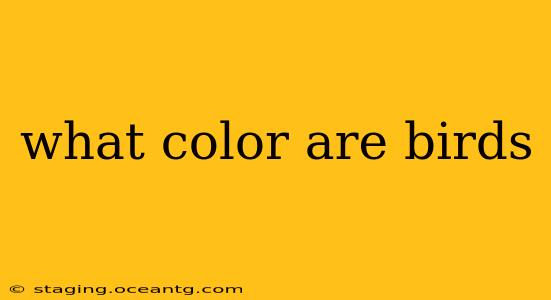Birds exhibit an astonishing array of colors, a vibrant tapestry woven from pigments, structural coloration, and the interplay of light and feather structure. There's no single answer to the question "What color are birds?" because the diversity is simply breathtaking. From the iridescent greens of hummingbirds to the stark white of snowy owls, the spectrum of avian coloration is incredibly vast and fascinating. Let's delve deeper into the science and artistry behind bird colors.
What Pigments Give Birds Their Color?
Many bird colors come from pigments within their feathers. These pigments are essentially colored chemicals that absorb certain wavelengths of light and reflect others, resulting in the color we see.
-
Melanin: This is the most common pigment in birds, responsible for browns, blacks, and grays. Different forms of melanin produce different shades. Eumelanin creates darker colors, while pheomelanin contributes to reddish-brown and yellow-brown hues.
-
Carotenoids: These pigments are derived from the bird's diet and create yellows, oranges, and reds. Birds obtain these through their food, often plants and insects rich in carotenoids. The intensity of the color often reflects the bird's diet and overall health.
-
Porphyrins: These pigments contribute to reddish, greenish, and brownish colors. They can also influence the fluorescence of feathers, creating a glowing effect under UV light.
How Do Structural Colors Work in Birds?
Beyond pigments, many bird colors are created by the structure of the feathers themselves. This is known as structural coloration. These colors are produced by the scattering and interference of light as it interacts with the microscopic structures within the feathers.
-
Iridescent Colors: These colors change depending on the angle of the light, such as the shimmering greens and blues seen in hummingbirds, peacocks, and many other species. This effect is caused by the precise arrangement of microscopic structures within the feather barbs.
-
Non-iridescent Colors: These colors are also structural, but they don't change with the angle of the light. They are often caused by the scattering of light by tiny structures within the feather, creating a uniform color. Examples include the brilliant blues of blue jays and the iridescent purples of some starlings.
Why Do Birds Have Different Colors?
The coloration of birds serves multiple purposes:
-
Camouflage: Many birds have colors that help them blend in with their environment, providing protection from predators. Think of the brown and mottled feathers of a woodcock, perfectly matching the forest floor.
-
Sexual Selection: Bright and striking colors are often used to attract mates. The elaborate plumage of male peacocks is a prime example of sexual selection. Females often choose males with the brightest and most impressive displays.
-
Species Recognition: Distinct colors help birds identify members of their own species. This is especially important during mating season.
-
Thermoregulation: In some cases, feather color can influence a bird's ability to regulate its body temperature. Darker colors absorb more heat, while lighter colors reflect more heat.
What are some examples of brightly colored birds?
Many birds exhibit stunning colors! Here are a few examples:
- Scarlet Macaw: Vibrant red, yellow, and blue plumage.
- Rainbow Lorikeet: A dazzling array of greens, blues, reds, and oranges.
- Resplendent Quetzal: Known for its incredibly long tail feathers and emerald green body.
- Kingfisher: Brilliant blues and greens.
How do birds get their colors from their diet?
As mentioned earlier, carotenoids are pigments obtained through diet. Birds consume fruits, vegetables, insects, and other foods containing carotenoids. The bird's body then processes these pigments and deposits them into the feathers during molting, resulting in the vibrant yellow, orange, and red colors. The intensity of these colors can reflect the quality and quantity of carotenoids in the bird's diet. A bird with a richer diet might have brighter, more intense colors than a bird with a less varied diet.
Can birds change color?
While many birds maintain the same color throughout their lives, some species can change color slightly, often in response to hormonal changes, molting, or seasonal shifts in environment. These changes are usually subtle, such as variations in the intensity of existing colors. However, dramatic color changes, like those seen in some chameleons, are not typical in birds.
In conclusion, the colors of birds are a result of a complex interaction of pigments, structural features, and the environment. This incredible diversity of color contributes significantly to the beauty and fascinating biology of birds worldwide.
